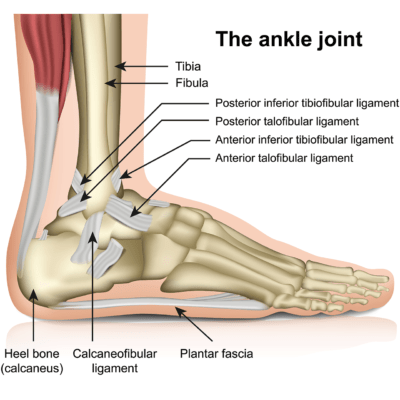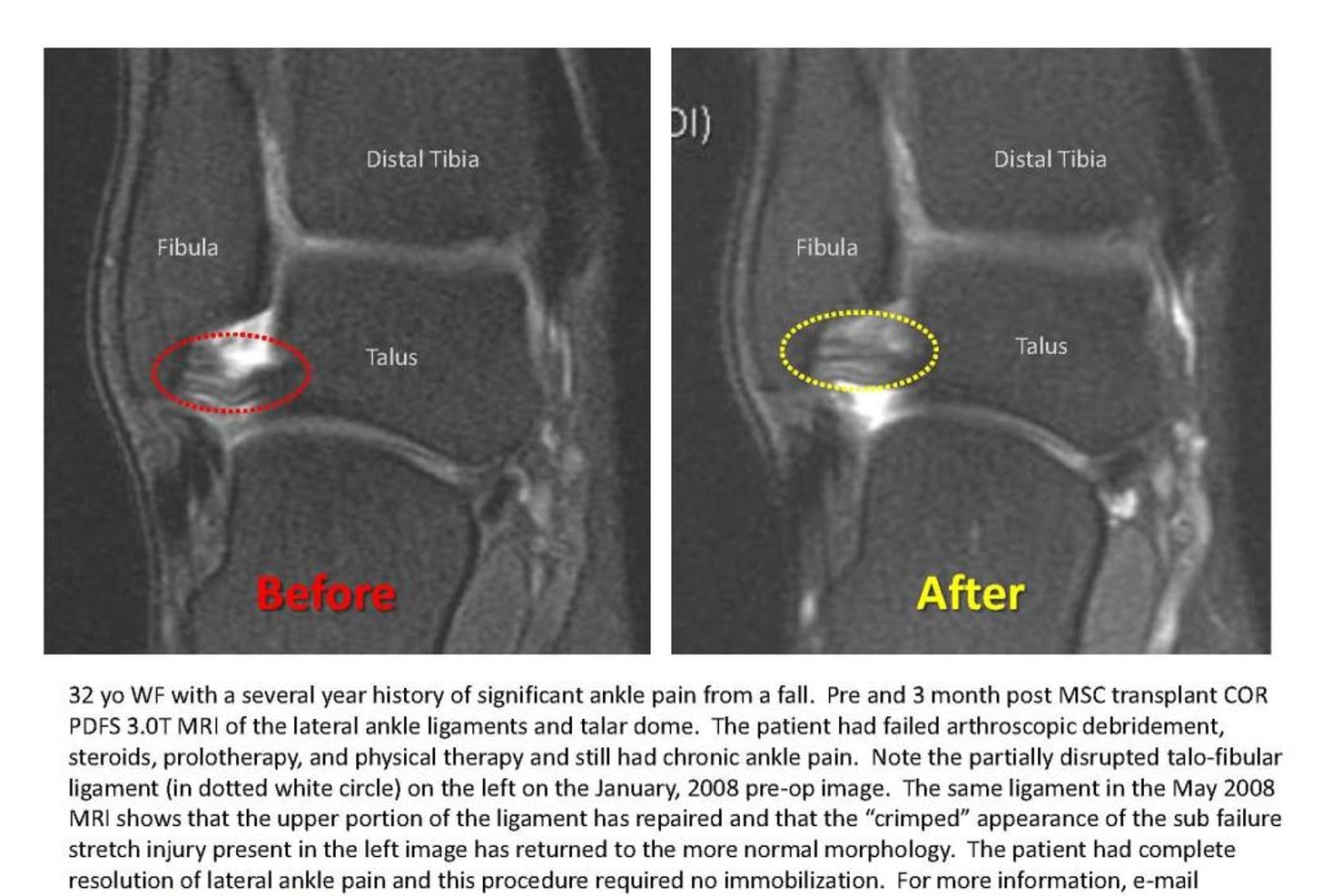Ankle Ligament Surgery? Do You Really Need it?
Do you need surgery for a torn ligament in the ankle? What is ankle reconstruction surgery? How long is the recovery from ankle surgery? Let’s dig in.
Which Ankle Ligaments?

Medicalstocks/Shutterstock
The ankle ligaments that are most commonly injured are the ones on the outside. I have highlighted these in yellow in the image on the left. They are the calcaneofibular (CF), anterior and posterior talofibular, and the anterior and posterior tibiofibular ligaments (1). They stabilize the main ankle joint and protect it while allowing motion. Notice that they create a star-like pattern.
Do You Need Surgery for a Torn Ligament in the Ankle?
The most surprising thing to me as a physician who helps patients avoid ankle ligament surgery is that it’s common for patients to get ankle surgery who don’t need it. So when do you need ankle ligament surgery and when is it unnecessary surgery? Let’s explore this problematic issue.
The ankle ligaments can be seen on MRI, so they are often diagnosed as being “torn” because the image of the ankle ligament looks lighter rather than darker which is normal (2). There are three basic kinds of ankle ligament tears:
- Partial
- Full, but the ligament is still intact
- Full, but the ligament is retracted back like a rubber band
Whether you can avoid ankle surgery depends on which type of ligament tear you have. For example, the vast majority of patients have the first two types (partial or full tears that aren’t retracted) and these are the patients that can likely avoid surgery. The issue is that the radiology reports often don’t describe if the tear is full and not retracted or retracted, making it sometimes impossible by reading the report to tell if the patient requires surgery. In addition, many surgeons often only read the report rather than looking at the films themselves.
What is Ankle Reconstruction Surgery?
The most common ankle ligament surgery procedure is the drilling of holes in the bones and rerouting the tendons to take the place of the ligaments (3). The tendon can be from the patient or from a cadaver.
Interestingly, there is no gold standard research that this type of surgery is more effective than just physical therapy, despite its widespread use (5). Complications can include nerve injury which has been reported as happening in 6-11% of the patients (6) The overall complication rate is fairly high, with arthroscopic surgery producing a 15% complication rate and open surgery producing a less, but still stout 8% complication rate (7). 7-9% of patients who get lateral ankle reconstruction will need a second reoperation because the first procedure failed (4).
How Long is the Recovery from Ankle Surgery?
In one recent study, athletes who only had an ankle ligament tear returned to training as early as 7-16 weeks (average 9 weeks) after a lateral ankle ligament reconstruction procedure (4). Return to sports took a bit longer at 7-22 weeks (average of 11 weeks). If there was another injury (like a cartilage tear in the main ankle joint), then return to training was on average 12 weeks and return to sports was 15 weeks.
Ankle Ligament Surgery Alternative
For the vast majority of patients in those first two categories described above (partial tears or a full tear with the ligament still intact) there is no reason to yank out the ligament, drill holes, and string a tendon. There are now newer non-surgical alternatives that use the patient’s own stem cells to heal the ligament by using only a precise ultrasound-guided injection. That procedure is called a Percutaneous Ankle Ligamentoplasty (PAL) procedure. We first began to perform this procedure over a decade ago and here is one of our early before and after MRIs:

The MRI shows that the CF ligament in the dashed oval that was torn has regenerated as a result of the PAL procedure. Again, this is without surgery. How easy is this to do? Not very, as it requires specialized training and using your own bone marrow stem cells. To see what this procedure looks like, see my video below:
How Can Stem Cells Regenerate the Ligament?
Mesenchymal stem cells from the bone marrow can both orchestrate a repair response by bringing other cells into the area as well as turn into ligament cells (8). The new ligament cells then secrete the stuff that makes up ligaments (collagen bundles). Hence, these stem cells have the ability to repair damaged ligaments.
Getting the Real PAL procedure versus a Fake
Lots of providers out there are offering seminars and fly by night “stem cell” procedures. To make sure you don’t waste your money and get scammed, especially by clinics selling amniotic and umbilical cord “stem cell” therapies containing dead cells, read my little book below:
The upshot? While some patients need ankle ligament surgery, the vast majority of people who tear their ankle ligaments do not need this procedure. Instead, they can use the PAL procedure to heal their own ligaments rather than getting them ripped out surgically and a tendon laced through the bones.
___________________________________________
References:
(1) Manganaro D, Alsayouri K. Anatomy, Bony Pelvis and Lower Limb, Ankle Joint. [Updated 2019 Aug 3]. In: StatPearls [Internet]. Treasure Island (FL): StatPearls Publishing; 2019 Jan-. Available from: https://www.ncbi.nlm.nih.gov/books/NBK545158/
(2) Salat P, Le V, Veljkovic A Cresswell ME. Imaging in Foot and Ankle Instability. Foot Ankle Clin. 2018 Dec;23(4):499-522.e28. doi: 10.1016/j.fcl.2018.07.011.
(3) Porter DA, Kamman KA. Chronic Lateral Ankle Instability: Open Surgical Management. Foot Ankle Clin. 2018 Dec;23(4):539-554. doi: 10.1016/j.fcl.2018.07.002.
(4) Yasui Y, Murawski CD, Wollstein A, Kennedy JG. Reoperation rates following ankle ligament procedures performed with and without concomitant arthroscopic procedures. Knee Surg Sports Traumatol Arthrosc. 2017 Jun;25(6):1908-1915. doi: 10.1007/s00167-016-4207-x.
(5) Kerkhoffs GMMJ, Handoll HHG, de Bie R, Rowe BH, Struijs PAA. Surgical versus conservative treatment for acute injuries of the lateral ligament complex of the ankle in adults. Cochrane Database of Systematic Reviews 2007, Issue 2. Art. No.: CD000380. DOI: 10.1002/14651858.CD000380.pub2.
(6) Early recovery after arthroscopic repair compared to open repair of the anterior talofibular ligament for lateral instability of the ankle. Matsui K, Takao M, Miyamoto W, Matsushita T. Arch Orthop Trauma Surg. 2016 Jan; 136(1):93-100. https://www.ncbi.nlm.nih.gov/pubmed/26467354/
(7) Guelfi M, Zamperetti M, Pantalone A, Usuelli FG, Salini V, Oliva XM. Open and arthroscopic lateral ligament repair for treatment of chronic ankle instability: a systematic review. Foot Ankle Surg. 2018 Feb;24(1):11-18. doi: 10.1016/j.fas.2016.05.315.
(8) Ramdass B, Koka PS. Ligament and tendon repair through regeneration using mesenchymal stem cells. Curr Stem Cell Res Ther. 2015;10(1):84-8. https://www.ncbi.nlm.nih.gov/pubmed/25274564

If you have questions or comments about this blog post, please email us at [email protected]
NOTE: This blog post provides general information to help the reader better understand regenerative medicine, musculoskeletal health, and related subjects. All content provided in this blog, website, or any linked materials, including text, graphics, images, patient profiles, outcomes, and information, are not intended and should not be considered or used as a substitute for medical advice, diagnosis, or treatment. Please always consult with a professional and certified healthcare provider to discuss if a treatment is right for you.
